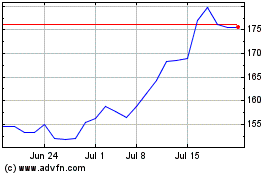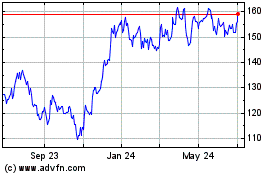3rd UPDATE: Wells Fargo Prices $10.65 Billion Offering To Repay TARP
December 15 2009 - 1:04PM
Dow Jones News
Wells Fargo & Co. (WFC) on Tuesday morning priced a stock
offering of $10.65 billion, intended to help it repay $25 billion
in government support. The bank said it could raise more capital to
avoid selling non-strategic assets.
The San Francisco bank's stock issue priced 426 million shares
at $25 each before the market opened. Wells Fargo agreed to raise
at least $10.4 billion in new capital as part of a deal with
regulators to exit the U.S. Treasury Dept.'s Troubled Asset Relief
Program, or TARP. Wells Fargo accepted $25 billion in TARP funds
last year when the federal government rescued the U.S. financial
system.
Shares of Wells Fargo recently traded up 1.8% to $25.94.
Wells Fargo said Tuesday during a conference call with investors
that it could raise an additional $1.56 billion as one way of
meeting additional government demands. Under the TARP exit
agreement, Wells Fargo agreed to either sell $1.5 billion in assets
by the end of 2010, or raise an additional $1.5 billion in capital.
If Wells Fargo chooses to sell assets, Chief Executive John Stumpf
said Tuesday those assets will not be strategic businesses.
Wells Fargo also said it will use the capital plan to resolve an
outstanding obligation tied to its purchase of Wachovia Corp. last
year.
When Wells Fargo agreed to buy Wachovia in 2008 as the Charlotte
bank crumbled under loan losses, Wachovia already had in place a
joint venture with Prudential Financial Inc. Under that joint
venture, which included a securities brokerage, Wachovia agreed
that Prudential could sell its minority interest in the venture to
Wachovia by Jan. 1, 2010, and in June, Prudential said it would
exercise that right.
Wells Fargo has not yet disclosed the value of that interest in
the venture, but the bank said previously it would pay Prudential
with some undetermined combination of cash and Wells Fargo stock,
which could dilute investors. But on Tuesday, Wells Fargo said it
would pay cash.
Wells Fargo struck its headline deal with the government after
Bank of America Corp. (BAC) and Citigroup Inc. (C) both signed
agreements with regulators to free themselves of the additional
layers of government oversight that have accompanied financial
support from taxpayers. Executives from the banks have praised the
federal government's rescue as effective, but have also chafed
against restrictions on top executives' lucrative compensation
packages as well as the government's stress tests, or close
examinations, of the largest financial institutions.
As Wells Fargo works to meet regulators' demands, Stumpf said
the bank is also trying to minimize diluting shareholders, whose
original shares of the company's profits and assets are reduced
when the company issues new stock.
"We want to minimize the dilution," Stumpf said during the
conference call.
PNC Financial Services Group Inc. (PNC), now the largest
American commercial bank to carry government support, has also said
repeatedly it's determined to pay back its $7.6 billion in public
funds "in a shareholder-friendly way." PNC said recently that other
banks' decisions to exit TARP had not affected PNC's plans to pay
back TARP next year.
Stumpf on Tuesday said Wells Fargo got the best deal it could
for its investors. "This was the most shareholder-friendly way, we
believe, that we could do this," he said.
-By Marshall Eckblad and Lynn Cowan, Dow Jones Newswires;
201-303-0544; marshall.eckblad@dowjones.com
(Matthias Rieker contributed to this report.)
PNC Financial Services (NYSE:PNC)
Historical Stock Chart
From Sep 2024 to Oct 2024

PNC Financial Services (NYSE:PNC)
Historical Stock Chart
From Oct 2023 to Oct 2024
